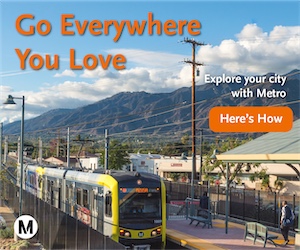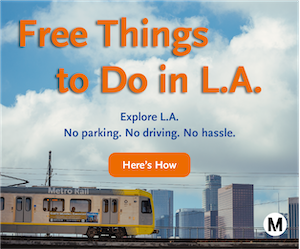I’ve spent a lifetime cultivating a love of this city, so when a friend posted that the editors of We Like L.A. were looking for new contributors, I jumped at the chance to sing her praises.
Perhaps it’s got something to do with the amount of time I’ve spent in traffic, but my favorite view of Los Angeles is from the car; looking up at the skyline just after rounding the curve from the 101 to the 110S, sunshine reflecting off the Bonaventure or the city lights shimmering against the darkened sky. For my seven-year-old son, it’s the haunted-house hole at the Sherman Oaks Castle that holds his gaze and fills him with joy. Yours might be waiting for the counter at Phillipe’s or waiting for a set at Porto…the point is that one of the most amazing things about our city is just how many places there are to love, and (if you dive into L.A.’s history) how many reasons there are to love them.

I don’t know if it’s just me, but after Halloween, as high-temperatures drop into the 60s and pumpkin-everything begins its spicy reign, the allure of the beach begins to fade and my thoughts turn to evenings spent indoors; discovering local craft brews and playing pub quizzes with my friends. We have a standing rule that whomever brings the best bit of trivial knowledge to the quiz that night drinks for free. It’s a long and gloriously inebriated tradition that only the brave should attempt (and only then with an uber at the ready).
It is with those shorter days and trivia-filled nights fast approaching that I offer you a brief glimpse into some of the lesser-known history of our city of angels.
Hopefully it’ll bring you some knowledge about L.A. that you weren’t previously equipped with. And if not, at least you can verify you know more about the city than probably anyone else in your social sphere.
Now on to the list…
1. August 2nd is L.A.’s nameday.
Many proud Angelenos know that the city once had a much longer name, but how many of you know how we got it? Father Juan Crespi was traveling through the area on a sunny Wednesday in 1769 with the first European expedition in California. Their group named the “beautiful river from the Northwest…at 34 degrees 10 minutes”
El Rio De Nuestra Señora la Reina de los Angeles de Porciúncula in celebration of the Feast of the Pardon of Saint Francis which takes place annually on August 2nd at the Porziuncola (which means small plot of land) chapel near Assisi and a fresco of the Virgin Mary painted there. In 1781 a settlement was founded along what we now call the Los Angeles River known by names ranging from the official El Pueblo de la Reina de Los Angeles, to the verbose El Pueblo de Nuestra Señora Reina de los Ángeles sobre el Río Porciúncula.
Sources:
lacity.org
Wikipedia
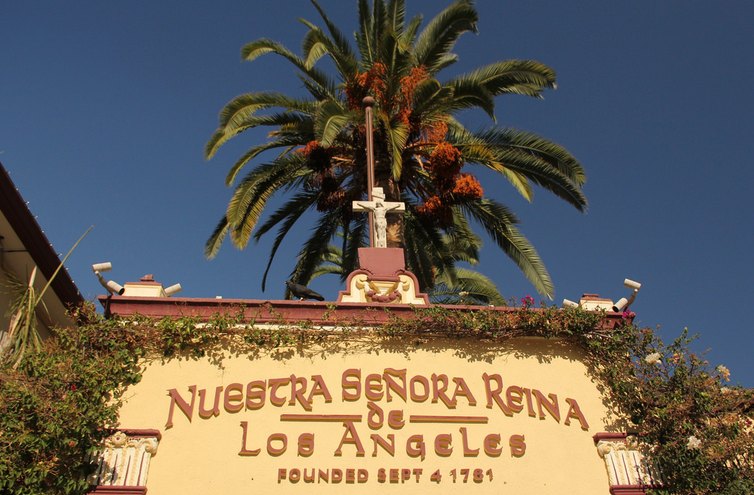
2. Public transit used to be a lot different here.
While it’s sadly mostly true that “nobody walks in L.A.” the city has a 140-year-old history of public transportation. In that time at least 220 public and private companies have contributed to the fascinating and troubling history of the city’s mass transit. At one point the old L.A. Rail system (Pacific Electric) was the largest operator of interurban electric railway passenger service in the world, with 2,160 daily trains over 1,000 miles (1,600 km) of track.
3. Iron Man was L.A.’s first crime boss.
No, not that one. Joseph “Iron Man” Ardizzone was the first head of the Los Angeles Crime Family that would include leaders Jack Dragna, Mickey Cohen and Bugsy Siegel.
Upside: Kept Angelenos drunk throughout prohibition. Downside: Claimed to have personally killed more than 30 men.
4. There are hidden tunnels under Los Angeles. Like, lots of them.
There are 11 miles of tunnels under the city of Los Angeles that have been used to transport prisoners and bodies; safely move billions of dollars and (only Joseph Ardizzone knows how many) bottles of prohibition era booze to underground speakeasies like The King Eddy Saloon. While the oldest tunnel dates back to the early 1900s (it connected a long-gone jail and courthouse), it was in the subsequent decades that tunnels were constructed that ran from Spring and Temple streets to 1st Street and Grand Avenue connecting many prominent downtown buildings.
More recently, damage from earthquakes and heightened security post-9/11 have most of the tunnels closed, though rumors persist that an elevator still runs adventurers down into the depths…not that we would recommend such things.
Sources:
L.A. Times
Atlas Obscura
5. We have the steepest street in California (take that Bay Area!).
If you’re not into subterranean activities of questionable legality, you can always explore some of the city’s above-ground oddities.. As it turns out, L.A. has the steepest drivable street in all of California.
And guess what, it’s not Baxter St. (like some of you may have thought), it’s actually Eldred St. over near Mt. Washington in Highland Park, which clocks in with a 33% elevation grade, which happesn to be 1.5% higher than the grades on two of San Francisco’s most notoriously steep streets, 22nd St. and Filbert.
Sources:
We Like L.A.
6. We were the first city to measure the speed of light.
The first modern and truly accurate measurement of the speed of light was conducted between 1924 and 1926 at Mount Wilson by Albert A. Michelson, who was America’s first Nobel Prize winner in a science field. The historic relevance of the Mount Wilson observatory doesn’t start with Michelson however, George Hale essentially founded the study of astrophysics at the observatory just after the turn of the 20th century.
Sources:
mtwilson.edu
Wikipedia
7. We banned the skyscaper (for a time).
Los Angeles didn’t permit any part of buildings other than decorative towers to be more than 150 feet high before the late 1950s. This restriction may well be partly responsible for the sprawling nature of the Southland.
The restrictions had another side effect: from its completion in 1928 until 1964, City Hall, at 32 floors and 454 feet in height, was the tallest building in LA, and is still the tallest base-isolated structure in the world. It is designed to stay standing after an 8.2 magnitude earthquake. Another factoid: its tower’s concrete was made with sand from each of California’s 58 counties and water from its 21 missions.
Sources:
KCET
dguides.com
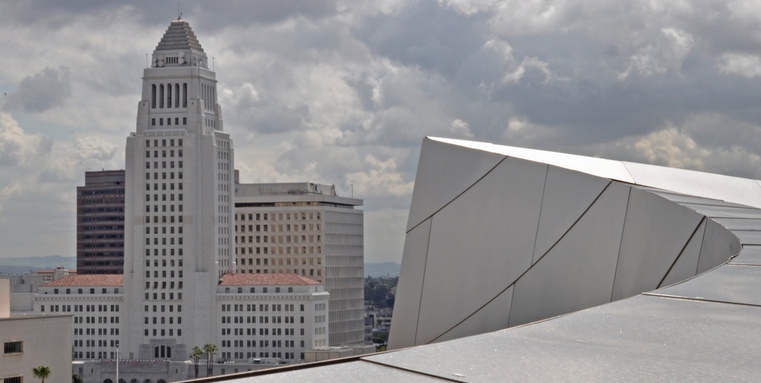
8. There was a ‘Battle of Los Angeles’ and people actually died.
There were five casualties in The Battle for Los Angeles which took place in February of 1942. The west coast of the United States was in a panic after the attack on Pearl Harbor in December, and a newly reported attack in Santa Barbara by a Japanese submarine.
Expecting an attack at any moment, the city was tense. At 3:16 on the morning of February 25th the 37th Coast Artillery Brigade began firing .50 caliber machine guns and 12.8-pound anti-aircraft shells into the air at reported aircraft; over 1,400 shells would eventually be fired. The casualties were from related car accidents and heart attacks brought on by the event.
No aircraft was recovered, but there were so many reports of sightings, that the story has turned into a bit of a UFO legend. Adding to that mystique, the military has changed their story on the matter several times, finally attributing the incident to “weather balloons.”
Sources:
Wikipedia
https://www.youtube.com/watch?v=qe0_wbVYIQ0
9. Little Tokyo became Bronzeville before it became Little Tokyo again.
By 1943 Little Tokyo was gone and the Bronzeville Chamber of Commerce was formed. It was in these first fear-filled days of the war that Executive Order 9066 was put into effect and Japanese immigrants and their families living on the west coast were forcefully relocated to internment camps for the duration of the war.
The relative ghost town that resulted left a void in the pockets of local property and business owners, who worked to bring new tenants and money into the area. The war sparked a labor shortage in L.A. which in turn brought new migration, largely from the deep south. These new residents transformed the area, opening breakfast clubs and keeping the party going late into the night.
Sources:
Wikipedia
Bronzeville.org
KCET
10. L.A. used to have a Little Italy.
Speaking of L.A.’s ethnic geography, you can find the hidden remnants of Little Italy strewn throughout the Puebla area of the city’s historic core. Since 1827, Italians have been making an impact on the city and its growth. Head down to the new Italian American Museum of Los Angeles to get some background, then take a stroll through Chinatown and Olvera street to find the Little Italy history beneath the surface. There’s some great (and by great, I mean, like…woah) walking and eating to be done in the area, so wear comfortable shoes and bring an appetite.
Sources:
Daily News
Italian Hall
KCET
11. Our freeways truly were ground breaking.
The “four-level” was the world’s first stacked interchange when it opened in 1953. It was where the Harbor, Hollywoood, Pasadena, and Santa Ana Freeways became 32 lanes moving in eight directions. Previous interchanges were all done in a cloverleaf style that made merging extremely difficult and dangerous. City planners saw the future of transportation, The Saturday Evening Post called it “a mad motorist’s dream, ” but for us, dear reader, it’s simply our rush-hour nightmare.
Sources:
History.com
12. The Capitol Records building has been sending out hidden messages since 1956.
On April 6, 1956 the spire atop the Capitol Records Building began spelling out H-O-L-L-Y-W-O-O-D in morse code. Even the most casual observer can see that the Capital Records Building resembles a stack of LPs, but the building’s designer, Lou Naidorf (who built the world’s first circular office building), didn’t have that in mind at all. Then Capital president Alan Livingston ordered the light as a sign that the label was the first with a presence in Los Angeles.
The light blinks out its message to this day, calling artists to one of the greatest music cities in the world.
Sources:
L.A. Times
Wikipedia
13. A tornado touched down in DTLA in the 1980’s.
Angeleno’s know that despite our (mostly deserved) reputation for nearly perfect weather year round, we have some weather of our own, and even our fair share of crazy meteorological events. In addition to the random snowstorms, fog banks, freezes and floods L.A. had an actual, real, honest to god tornado touchdown in DTLA in 1983 (see, Sharknado IS possible).
Sources:
We Like L.A.
National Weather Service
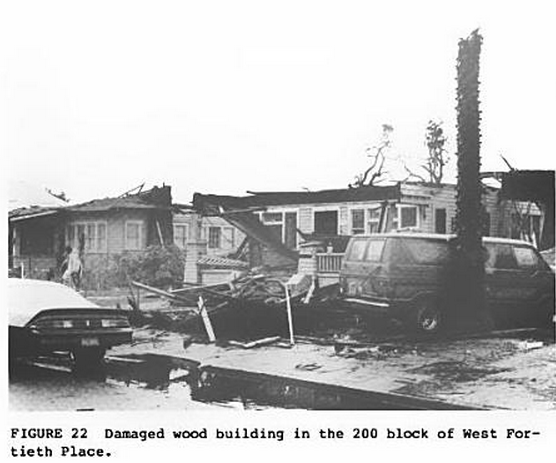
Do you know any funky facts about L.A. that you’d like to share with the community? Let us know your favorites in the comments below!
advertisements
